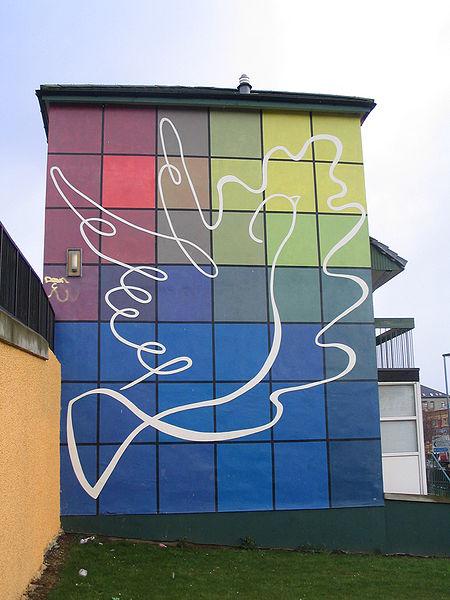 Despite the striking political gains made in Northern Ireland since 1998’s Good Friday Agreement, its power-sharing government again verged on collapse in early February, due to a policing and justice dispute. In the end, marathon negotiations forged a deal to keep afloat the 12-member cabinet.
Despite the striking political gains made in Northern Ireland since 1998’s Good Friday Agreement, its power-sharing government again verged on collapse in early February, due to a policing and justice dispute. In the end, marathon negotiations forged a deal to keep afloat the 12-member cabinet.
Peacemaking is rarely linear. As evidenced by a recent surge in dissident Irish Republican Army (IRA) violence and continued unionist grumblings over contentious Protestant marches, the Irish peace process may hit some future snags. But more has been achieved to date than anyone ever imagined just 12 years ago.
Moreover, an on-track Northern Ireland is also in the Obama administration’s interest — both for its symbolic and economic significance. During his trips to Israel and the occupied territories, Middle East envoy George Mitchell has cited the seemingly insurmountable hurdles cleared during his tenure as the chair of the Irish peace talks. Meanwhile, to assist Belfast in courting the U.S. corporate investment it considers vital to underpinning the peace, Hillary Clinton last year revived the Economic Envoy to Northern Ireland post created by her husband in the 1990s.
Given ongoing global economic jitters, Clinton’s envoy faces no easy task. Recent IRA dissident attacks aimed at fomenting political instability won’t help either. But the peace process ultimately depends not on outside mediators, but locals. And it will be the ongoing strength of their efforts, not Washington’s, that will determine how future challenges will be met.
Continued Violence
The small bands of IRA renegades trying to derail the peace process have nowhere near the military capacity or poplar support enjoyed by the mainstream IRA (the Provisional IRA) during its decades-long campaign. However, they are also far from irrelevant.
In March 2009, dissidents killed two British soldiers and a policeman within a three-day span — the first-ever fatalities they’ve inflicted on the security forces.
Last September, British army technicians defused a 600-pound explosive device planted near the South Armagh village of Forkhill. Two months later, a 400-pound car bomb left outside the Belfast headquarters of a civilian policing oversight body only partially exploded. In January of this year, dissidents exploded a bomb under an off-duty policeman’s car. He lost a leg from injuries suffered.
The attempts have continued this year. On April 12, the day that policing and justice powers were devolved, IRA dissidents exploded a small car bomb outside the local headquarters of MI5, Britain’s domestic spy agency, on Belfast’s outskirts. Less than two weeks later, dissidents struck again, detonating a large car bomb in the border village of Newtownhamilton. And on May 22, Irish police claimed that they foiled an imminent dissident bombing mission when they swooped down on a farmhouse near the border with Northern Ireland and arrested two men allegedly working at a dissident IRA “bomb factory.” All this has resulted in the dissident threat being classified as “severe.”
There are three main dissident IRA factions; the Continuity IRA (CIRA), the self-styled Real IRA (RIRA), and Óglaigh na hÉireann. A fourth splinter group, the Irish National Liberation Army (INLA), called a ceasefire in 1998. And, while still opposed to a peace process it believes has strengthened British rule, the INLA recently completed the decommissioning of its weaponry.
The INLA’s disarmament came as the largest loyalist paramilitary group, the Ulster Defense Association/ Ulster Freedom Fighters (UDA/UFF), also announced its full disarmament, completing the loyalist decommissioning that the rival outlawed Ulster Volunteer Force had announced last June.
None of this matters to IRA dissidents. After years of botched attacks and interceptions by the security forces, their sophistication and lethal capacity appears to be growing. Police even warned Sinn Fein leader Gerry Adams and other members of his party that dissidents are plotting to assassinate them.
At its height, the mainstream IRA drew recruits from many economically devastated areas where unemployment was astronomical. Although the conditions have vastly improved for most people in the North in recent years, its leaders are keen to maintain the steady stream of inward investment that began flowing especially from America after the Good Friday Agreement — particularly at a time of economic downturn in Ireland and Europe more generally.
The Role of Washington
U.S. foreign policy has never been motivated by pure altruism. Trade and economics always reign supreme when policymakers in Washington chart global strategies. Given its tiny size and relative lack of natural resources, Northern Ireland has surprisingly received a remarkable amount of attention from Oval Office occupants during the last two decades.
In December 1994, Bill Clinton took the unprecedented step of naming former senator George Mitchell as the first White House economic envoy to Northern Ireland. Mitchell went on to chair peace talks that culminated in 1998’s Good Friday Agreement. In January 2009, he became the Obama administration’s point-person in the Middle East. The difficulties he’s experienced in his new role are a stark reminder that the Irish peace process model isn’t a one-size-fits-all template. Nonetheless, many in Washington continue to cite the Irish peace-making model as an inspiration.
In addition to Mitchell, Bill Clinton also appointed a special economic envoy, Jim Lyons, who tried to help bring investment to Northern Ireland from 1997 until 2001. George W. Bush appointed three political envoys – Richard Haass, Mitchell Reiss, and Paula Dobriansky. All three applied varying degrees of support and pressure during the various political logjams that have slowed the process.
Since taking the helm at the State Department, Hillary Clinton has tried to increase the flow of U.S. investments. Last August she named Declan Kelly, a New York-based Irishman, as her economic envoy to Northern Ireland. A few weeks later, at Kelly’s request, Bill Clinton sat on a stage in New York with the leaders of Northern Ireland’s cabinet — Martin McGuinness of the IRA-allied Sinn Fein and Peter Robinson of the hard-line Democratic Unionist Party. Clinton was making an hour-long investment sales pitch to the well-heeled attendees at the fifth annual meeting of his Clinton Global Initiative. Next fall, Hillary Clinton and Kelly will convene a one-day conference in Washington to promote investment in the North.
Since becoming Foggy Bottom’s heaviest hitter, Hillary Clinton has made it clear on several occasions that, in her capacity as secretary of state, she has a personal interest in staying involved with Ireland. That may be true. But reality also dictates that, given the many diplomatic balls she has to juggle (as evidenced by the recent flaring of tensions on the Korean peninsula), Northern Ireland’s slots in her datebook will be very limited.
The White House dimension, while great for headlines and photo ops, has also ironically proved the axiom that all politics is local. The crucial decisions and compromises that have really mattered in the peace process have always been made by local Northern Irish players.
What’s Next for Northern Ireland
Northern Ireland’s current power-sharing incarnation, which resulted from an unexpected breakthrough at talks held at St. Andrews, Scotland in October 2006, has made coalition allies of Sinn Fein and the unionist Democratic Unionist Party (DUP). Although occasionally hitting choppy seas since first partnering in May 2007, the DUP and Sinn Fein remain committed to powersharing for the foreseeable future.
The February deal that averted a cabinet collapse earlier this year cleared the way for April’s appointment of the first local justice minister since 1972 (when London imposed direct rule during the most violent year of the Troubles). In the May British general election, although DUP leader Peter Robinson lost the Westminster seat he’d held for 31 years (a loss born of family and financial scandals), the DUP trounced a breakaway faction that opposes powersharing with Sinn Fein.
But flies in the ointment remain. Just days after February’s Hillsborough Agreement was reached, DUP leader Peter Robinson hinted that his party may collapse the government by year’s end, unless Sinn Fein helps find a formula to allow Protestant marchers back into overwhelmingly Catholic areas from which they’ve been banned for years. Robinson may or may not be serious. But, in some ways, it really doesn’t matter.
Some 17 years after its initial steps became public, the Irish peace process has weathered many crises. Violence from IRA dissidents will likely continue for the foreseeable future, as will the flaring of sometimes lethal sectarian tensions. Disagreements between unlikely political bedfellow like the DUP and Sinn Fein will also periodically arise.
But the major players on both sides having repeatedly stretched themselves for peace. Even if the power-sharing cabinet falters again over the issue of contentious Protestant parades, the peace process will survive and continue to be an inspiring example of how seemingly intractable conflicts can eventually be transformed.
